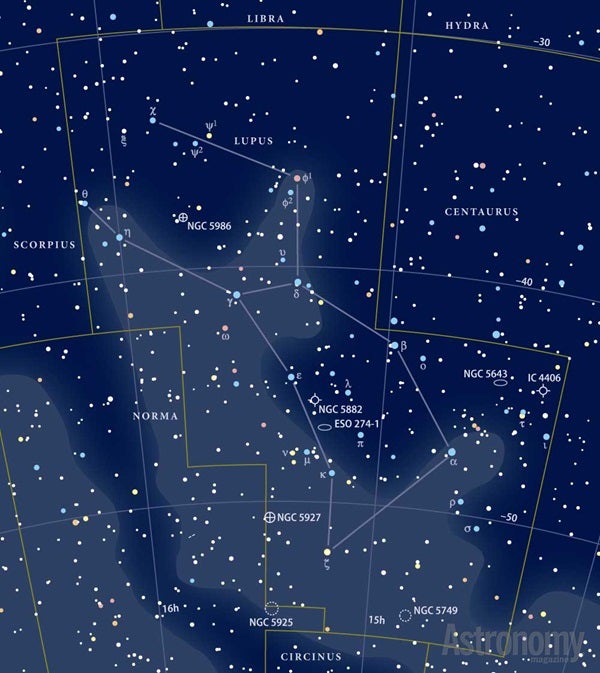Targets for July 21–28, 2016
Small telescope: A trio of double stars
Large telescope: Globular cluster NGC 5927
Large telescope: Spiral galaxy NGC 5899
A triple-double
This week’s small-telescope targets are three double stars. The first is Delta (δ) Serpentis. It lies 21° east-southeast of brilliant Arcturus (Alpha [α] Boötis).
This “star” actually is a pair of binary stars separated by 66″. The set you’ll be observing is the A-B pair, which has a separation of 4″. The yellow-white primary shines at magnitude 4.2. The secondary — also yellow-white — is 40 percent as bright at magnitude 5.2.
The C-D pair is just a bit wider at 4.4″, but the stars glow dimly at magnitudes 13.9 and 14.6, respectively. You can try for them if you have a 16-inch or larger telescope at your disposal.
Our second double star is Struve 1962 in Libra. It lies 5.4° east of magnitude 2.6 Zubeneschamali (Beta [β] Librae).
This pair of equally bright stars — magnitudes 6.4 and 6.5 — aligns along a roughly north-south line. The separation is 11.7″ and both stars are white or blue-white.
Our third binary star this week is Zeta (ζ) Coronae Borealis, which lies in the northern part of the constellation, about a “crown’s width” north of the Northern Crown asterism.
The brighter of the pair shines at magnitude 5.0 and its companion glows at magnitude 5.9. An angular distance of 6.0″ separates the stars. Most observers peg the colors of these two suns as blue-white or white.
Easy to see, tough to resolve
This week’s first large-scope object is globular cluster NGC 5927 in the constellation Lupus the Wolf.
To find it, point your telescope 2.9° east-northeast of magnitude 3.4 Zeta (ζ) Lupi. An 8-inch scope shows a magnitude 8.0 cluster 12′ in diameter. It has a dense core and a ragged outer edge. A 20-inch scope at a magnification of 300x will resolve some 50 stars, but the core will appear just as dense as through the smaller instrument.
Look for a similarly difficult-to-resolve globular, magnitude 8.4 NGC 5946, 1.2° due east of NGC 5927.
A galactic quartet
This week’s second large-telescope target is spiral galaxy NGC 5899 in Boötes the Herdsman. It glows softly at magnitude 11.7 and measures 3.3′ by 1.4′.
You’ll find this object, and three other galaxies, 3° northeast of magnitude 3.5 Nekkar (Beta [β] Boötis). The orange magnitude 6.1 star SAO 45445 lies 0.2° to the northwest. Through an 8-inch telescope, you’ll see a disk-shaped object more than twice as long as it is wide oriented north-northeast to south-southwest. The galaxy’s northern half glows a bit more brightly than the southern portion.
Through at least a 14-inch scope from a dark site, you can search for a trio of faint galaxies near NGC 5899. Look 9′ north for magnitude 14.1 NGC 5900. Magnitude 14.3 NGC 5895 lies 14′ west-southwest, and magnitude 13.2 NGC 5893 sits 4′ southwest of NGC 5895.
Expand your observing at Astronomy.com
The Sky this Week
Get a daily digest of celestial events coming soon to a sky near you.
Observing Basics
Find more guidance from Senior Editor Michael E. Bakich with his Observing Basics video series.










